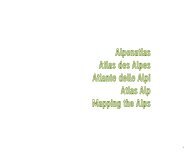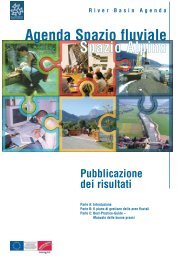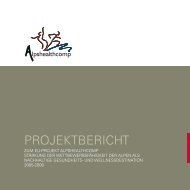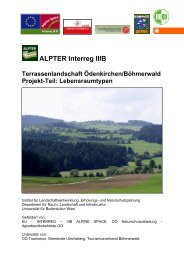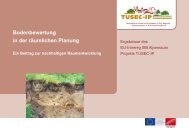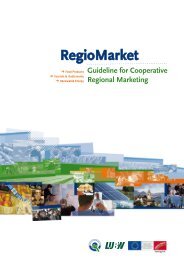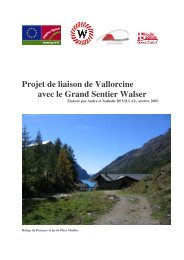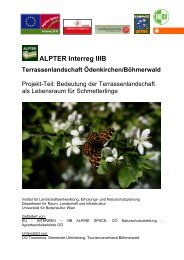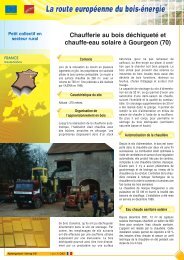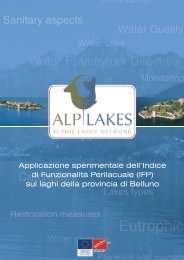WALSERSPRACHE - The four main objectives of the Alpine Space ...
WALSERSPRACHE - The four main objectives of the Alpine Space ...
WALSERSPRACHE - The four main objectives of the Alpine Space ...
Create successful ePaper yourself
Turn your PDF publications into a flip-book with our unique Google optimized e-Paper software.
Max Waibel<br />
Should <strong>the</strong> experiment <strong>of</strong> reviving <strong>the</strong> Walser language fall through, no one could blame<br />
governmental policies, since <strong>the</strong>y are quite favourable. <strong>The</strong> question deeply embedded in <strong>the</strong><br />
revitalisation <strong>of</strong> <strong>the</strong> language, something I personally have no answer to, goes a bit like this:<br />
how could one possibly get young people excited about a dialect which is unwieldy when it<br />
comes to practical matters? And that ushers in straightaway <strong>the</strong> next question: which contents<br />
should be carried forward? It is a fact that in <strong>the</strong> last 100 years <strong>the</strong> entire alpine living<br />
space (and with it <strong>the</strong> Walser space as well) has suffered a setback which by far tops<br />
what happened in <strong>the</strong> previous 700 years. In <strong>the</strong> process <strong>the</strong> <strong>main</strong> kernel <strong>of</strong> civilisation<br />
expressed by <strong>the</strong> language <strong>of</strong> <strong>the</strong> Walsers has gone awash. That concerns <strong>main</strong>ly <strong>the</strong> old<br />
mountain husbandry, <strong>the</strong> ways and means <strong>of</strong> living on and <strong>of</strong>f mountain territory. <strong>The</strong>re<br />
is nothing anymore governments could possibly do to bring back a way <strong>of</strong> life conveyed by<br />
sentences like: «ich hän gmolchu di Geiss» or «ds Schaaf hed di Wollu». And by which o<strong>the</strong>r<br />
way, <strong>the</strong>n? Three realms could be taken into serious consideration: 1) <strong>the</strong> family, 2) <strong>the</strong><br />
neighbourhood, 3) <strong>the</strong> companionship. Popular lore, deeply rooted in all three, could well<br />
be used to revitalise <strong>the</strong> language. <strong>The</strong> question however is how … <strong>The</strong>re could be some possibilities<br />
with recordings, which were engraved in <strong>the</strong> sou<strong>the</strong>rn Walser area. Heinrich Welf<br />
is <strong>the</strong> story-teller <strong>of</strong> <strong>the</strong> first tale. Follows a folk-tale. First, we should make sure all those who<br />
listen can understand. <strong>The</strong>re is a lot one could talk about and young people could discuss<br />
with elders how to concoct new tales or revive waning forms <strong>of</strong> story-telling. Follows ano<strong>the</strong>r<br />
recorded anecdote. One could wonder if perhaps parents or grandparents do not by any<br />
chance know similar stories, in Italian, or in French, which might have been carried over<br />
into <strong>the</strong> language <strong>of</strong> <strong>the</strong> Walsers. One could also talk a lot about <strong>the</strong> core <strong>of</strong> this anecdote.<br />
Follows an amusing story. It also was recorded in Macugnaga and <strong>the</strong> voice is that <strong>of</strong><br />
Augusto Pala. One could have a hearty laugh about <strong>the</strong> gullibility <strong>of</strong> countryside folks and<br />
jokes on neighbours, using <strong>the</strong> Atlas <strong>of</strong> <strong>the</strong> Swiss Popular Harbinger which has appeaing<br />
since 1977. Old customs could be revived from <strong>the</strong> motifs in <strong>the</strong> story. Let us now come to<br />
oral history. Many Walser places stand out as some <strong>of</strong> <strong>the</strong> most picturesque in <strong>the</strong> central<br />
Alps, but <strong>the</strong>ir beauty does not come without a price: snow slides and floodings worked<br />
havoc. Walsers are not blameless, since <strong>the</strong>ir ancestors saw an enemy in every forest. Only<br />
in <strong>the</strong> twentieth century some repair work was done. «<strong>The</strong> avalanche goes, where she<br />
already went, where she has not as yet gone, and where she never will go again” goes an<br />
old proverb. How true it is, was too well demonstrated by <strong>the</strong> catastrophic slide in Galtür on<br />
February 23 rd , 1999, which took 31 lives. Let us finger through older documents. Follows a<br />
description and a dialogue in Alagna’s Walser. This document brings to <strong>the</strong> fore some noteworthy<br />
elements: new things, specially technical devices, have entered <strong>the</strong> language as loan<br />
words. Quite likely Maria Ghigher, who told <strong>the</strong> tale, had never heard <strong>the</strong> German word<br />
«Strom» (current), so she thought she had something to apologise for, something which she<br />
felt she should have known. Well, even loan words could become bargaining chips on <strong>the</strong><br />
road to revitalisation. One question could be: why are modern appliances called with<br />
Italian names in Walser settlements in Italy? By telling similar stories to older generations<br />
59



